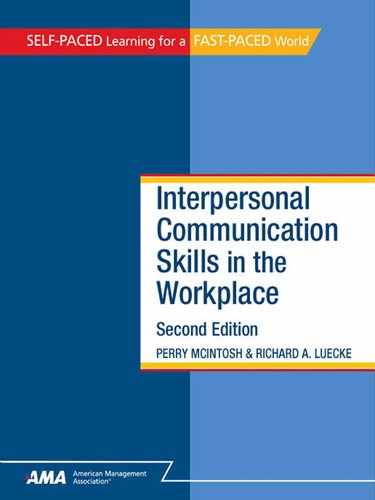Pre-Test
Interpersonal Communication Skills in the Workplace
Second Edition
Course Code 97003
INSTRUCTIONS: Record your answers on one of the scannable forms enclosed. Please follow the directions on the form carefully. Be sure to keep a copy of the completed answer form for your records. No photocopies will be graded. When completed, mail your answer form to:
Educational Services
American Management Association
P.O. Box 133
Florida, NY 10921
1. Which of the following is one of the building blocks of persuasion?
(a) Trust
(b) Practice
(c) Sales experience
(d) Observing others
2. Compared to people from Northern Europe or the United States, business people in Japan and Latin America typically spend time ____________________ before getting down to business.
(a) checking the other person’s credentials
(b) clearing up disagreements
(c) testing the other person’s negotiating skills
(d) building trust and a personal relationship
3. Part of being an effective persuader is:
(a) appealing strictly to the emotions of people in the group.
(b) capitalizing on misinformation.
(c) pointing out the worst-case scenario.
(d) identifying the key decision makers.
4. Which of the following is a characteristic of the ‘new’ workplace described in this course?
(a) Command-and-control management
(b) Geographically dispersed or offsite work
(c) At least three different languages spoken routinely by employees
(d) Frequent meetings
5. Which of the following best describes a communication barrier?
(a) Multitasking
(b) Something that keeps us from fully understanding others
(c) Interruptions
(d) Job description
6. Which of the following has been shown to reduce the frequency with which coworkers communicate?
(a) Gender differences
(b) Background noise
(c) Frequent deadlines
(d) The physical distance between them
7. In an effective dialogue, the parties communicating:
(a) listen attentively, then respond.
(b) aim to make the winning argument.
(c) adopt a debating mode.
(d) seek consensus.
8. One of the reasons that change is a challenge to effective workplace communication is that:
(a) operating manuals must be rewritten.
(b) people must learn how to communicate with new coworkers.
(c) consensus must be achieved.
(d) change makes people uncomfortable.
9. An introverted person prefers to:
(a) think about information and develop plans before discussing them with others.
(b) develop ideas by talking them through with others.
(c) trust her instincts when making decisions.
(d) meet and talk with other people.
10. A good listener will periodically ask ________________ to check that he or she has understood the speaker’s intended meaning.
(a) for a short break
(b) to consult his or her notes
(c) clarifying questions
(d) for time
11. As a communication method, feedback always involves:
(a) the supervisor-subordinate relationship.
(b) interpersonal conflict.
(c) a one-way conversation.
(d) giving and receiving information.
12. When they communicate, people from Arab and Latin American cultures tend to:
(a) quickly get down to business.
(b) use few facial expressions.
(c) stand very close to their listeners.
(d) minimize body language.
13. In nonverbal communication, crossing the arms across the chest may be an indication of:
(a) agreement.
(b) defensiveness.
(c) hostility.
(d) aggression.
14. One technique for effective listening is to periodically ____________ what the other person has said.
(a) memorize
(b) repeat exactly
(c) write down
(d) paraphrase
15. Ineffective communication occurs when:
(a) the speaker shifts body position frequently.
(b) people from different cultures work together.
(c) the meaning is not understood.
(d) listeners fail to take notes.
16. A person who aims to give effective feedback should focus on:
(a) positives and negatives equally.
(b) only those things that the other person is prepared to hear.
(c) negative behaviors that reduce team performance.
(d) modifiable behaviors, not unchangeable ones.
17. Many businesses use the _________________ system to understand personality and personality preferences with respect to communications, decision making, and group-based work.
(a) Jungian
(b) Intellimetrics
(c) Intuitive
(d) Myers-Briggs
18. The research of G. Hofstede describes four dimensions of ___________________ that we should be aware of in our communications with others.
(a) groupthink
(b) attitude alignment
(c) language difficulties
(d) cultural differences
19. Nominal group technique is a method for:
(a) drawing out ideas and problem solutions from participants.
(b) establishing a hierarchy of acceptable solutions.
(c) challenging people’s assumptions.
(d) rapid communication.
20. Imagine a situation in which clerical workers communicate with their supervisors, and supervisors decide what information should be passed up to the next level of management. That type of communication is characteristic of:
(a) the ‘new’ workplace.
(b) a command-and-control workplace.
(c) a distributed workplace.
(d) an offsite workplace.
21. The _________________ of a verbal exchange can make a greater impression than the words used.
(a) decibel level
(b) frequency pitch
(c) volume and tone
(d) word rhythm
22. To encourage communication during a meeting where opinions and information need to be shared, try:
(a) limiting the number of participants to ten or fewer.
(b) setting a meeting deadline.
(c) offering food.
(d) making sure that people of different organizational status are present.
23. When you tell a coworker, “I’ll do that assignment; it’s really difficult. Why don’t you try this easier one?”, you are committing which bad verbal habit?
(a) Talking down
(b) Talking up
(c) Failing to delegate
(d) Negative substitution
24. Identify a powerful form of nonverbal communication that must be in alignment with verbal communication.
(a) Clothing
(b) Hair style
(c) Career attitude
(d) Personal example
25. People with diametrically opposed personality types can actually communicate and work together very well when:
(a) they avoid issues on which they are likely to clash.
(b) their differences complement one other in positive ways.
(c) people with other preferences are not part of the team.
